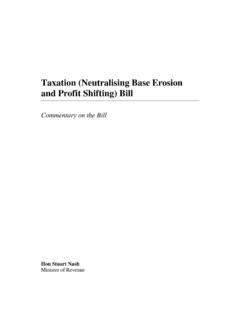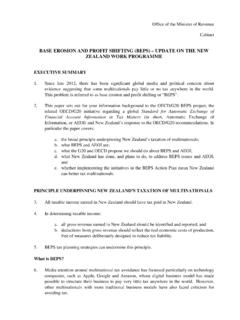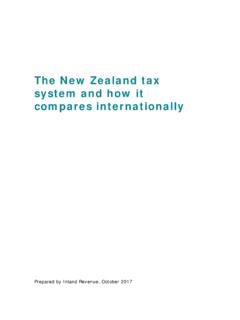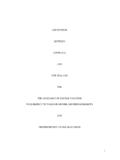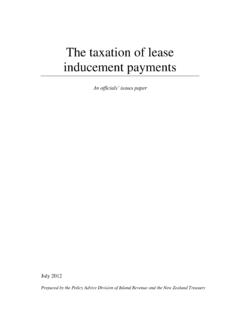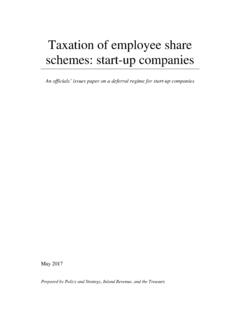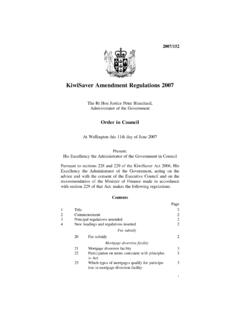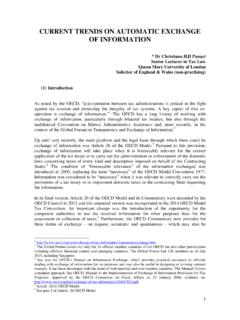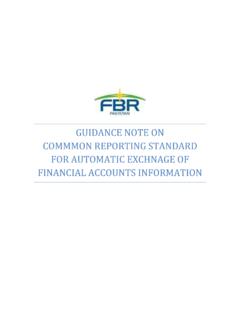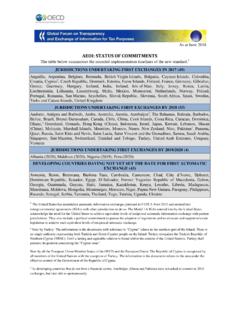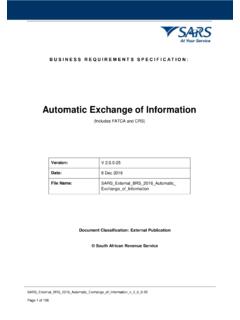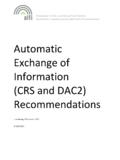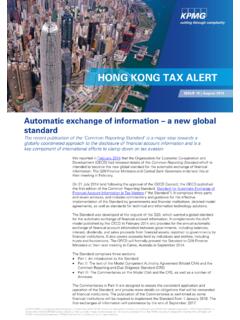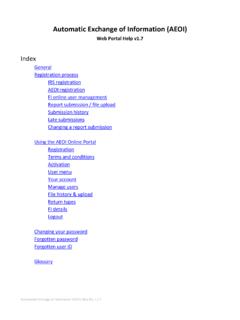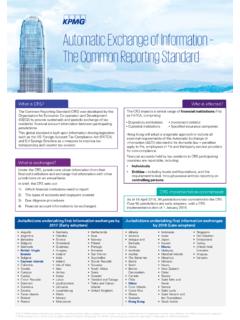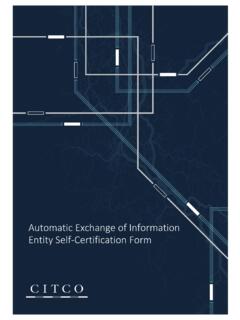Transcription of Automatic exchange of information - Tax Policy, Inland …
1 February 2017. A special report from Policy and Strategy, Inland Revenue Automatic exchange of information This special report provides early information on changes that have been made to the Income Tax Act 2007 (ITA) and Tax Administration Act 1994 (TAA) to incorporate the G20/OECD. standard for Automatic exchange of Financial Account information in Tax Matters into New Zealand domestic law. 1. The standard is usually referred to as Automatic exchange of information , AEOI , or the AEOI standard . AEOI is a global initiative, led by the G20 and OECD, to address the international problem of offshore tax evasion (that is, evading tax by hiding wealth in offshore accounts).
2 Broadly, a jurisdiction implements the AEOI standard by enacting legislation that requires financial institutions to: conduct due diligence on their financial accounts to identify those held or (in certain circumstances) 2 controlled by non-residents; and report specified identity information (including tax residence) and financial information (such as account balances and interest earned) in respect of those accounts to their local tax administration. Implementing jurisdictions must also have an appropriate network of tax treaties in place to exchange the reported information with applicable participating jurisdictions.
3 Although different types of tax treaty can be used for this purpose, AEOI exchanges will predominantly be made under the joint OECD/Council of Europe Multilateral Convention on Mutual Administrative Assistance in Tax The exchanged information will be used by tax administrations to verify compliance with tax obligations. 1. For information on the standard see 2. Certain entity account holders must be looked through to identify the ultimate natural persons who have effective control or deemed control of the financial account. 3. For information on the Convention see 1.
4 This special report outlines and explains the legislative changes at a relatively high level. Inland Revenue is supplementing this report with comprehensive guidance that will deal with the application of the AEOI standard and this implementation legislation at a detailed technical level. (The guidance was issued in draft form in December 2016, and submissions were called for by 28 February 2017. After the submissions are reviewed the guidance will be finalised and published on Inland Revenue's website.). Key features The AEOI implementation legislation focuses on imposing the necessary due diligence and reporting obligations on financial institutions.
5 (Exchanging the reported information is primarily a tax treaty matter and generally does not require implementation legislation.). The due diligence and reporting obligations to be imposed are set out in an element of the AEOI standard known as the Common Standard On Reporting And Due Diligence For Financial Account information (in short, the Common Reporting Standard or CRS ). 4. The CRS is also supplemented by a comprehensive official OECD Commentary (the OECD. Commentary ). The approach adopted in the legislation is essentially to incorporate the CRS directly into New Zealand law by reference, and to require the application of the CRS to be consistent with the OECD Commentary.
6 Because of similarities between the CRS and the related United States Foreign Account Tax Compliance Account ( FATCA ) initiative, the CRS implementation legislation has primarily been located (and merged) with the FATCA framework legislation at Part 11B of the Tax Administration Act 1994. The general scheme of Part 11B has been retained. Section 185E, which sets out the purpose of Part 11B, has been updated to include references to the CRS and to outline the new structure. Some provisions in Part 11B (namely sections 185F to 185M) apply solely to FATCA, some (sections 185N and 185O) apply solely for CRS purposes, and some (sections 185P to 185R) apply for both FATCA and CRS purposes.
7 A number of other amendments have been made to the Income Tax Act 2007 and the Tax Administration Act 1994, to support the operation of Part 11B. These include: new definitions (in both Acts);. new record-keeping provisions (in subsection 22(2) of the Tax Administration Act);. new penalty provisions (at sections 89C, 142H and 142I of the Tax Administration Act);. new determination and Order in Council-making powers (at new sections 91 AAU, 91 AAV, 91 AAW, 226D and 226E of the Tax Administration Act); and a new Schedule 2 to the Tax Administration Act (modifying the application of the CRS.)
8 To New Zealand). 4. For information on the CRS see 2. All of these amendments are detailed and explained in this special report. Terminology Given that the focus of the legislation is on incorporating CRS obligations into New Zealand law, this report will primarily refer to the CRS rather than AEOI or the AEOI Standard. The CRS contains numerous definitions that are potentially confusing. Examples include: The term entity includes legal arrangements such as trusts, which would not normally be the case under New Zealand law. The terms financial institution and financial account have wider application than might normally be expected.
9 For instance, a professionally managed investment trust that meets specified criteria will be a financial institution for CRS purposes. Moreover, a settlor or beneficiary of such a trust will be deemed to hold a financial account with the trust. New Zealand start date The start date to which the New Zealand Government has committed internationally, and from which the legislation provides that CRS obligations are to apply in New Zealand, is 1 July 2017. Due diligence The legislation specifies due diligence procedures that financial institutions must undertake in order to determine if any of their accounts are held or (if look-through rules apply).
10 Controlled by non-residents. From 1 July 2017, the due diligence procedures must be conducted in respect of all new accounts. 5. Due diligence for new accounts will generally involve obtaining, on account opening, self-certifications that contain the required identity and tax residence information . From 1 July 2017, financial institutions must also begin due diligence reviews in respect of all pre-existing accounts. 6. Different due diligence procedures are specified for different types of pre-existing accounts. In general, however, financial institutions will often be able to rely on documentation and/or information that they have already obtained for other regulatory or customer relationship purposes.
